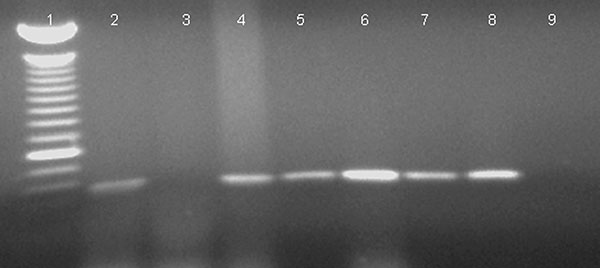Volume 10, Number 2—February 2004
THEME ISSUE
2004 SARS Edition
SARS Origins
Susceptibility of Pigs and Chickens to SARS Coronavirus
Figure

Figure. Amplification of severe acute respiratory syndrome–associated coronavirus (SARS-CoV) RNA in chicken blood, using one-step and two-step reverse transcriptase–polymerase chain reaction (RT-PCR) with nucleocapsid primers. Lane 1: 100-bp ladder, the bright band representing 600 bp; Lane 2: chicken 115, 2 days postinocuation (dpi), one-step RT-PCR; lane 3: chicken 115, 2 dpi, two-step RT-PCR (detecting negative-strand RNA); lane 4: chicken 117, 3 dpi, one-step RT-PCR; lane 5: chicken 117, 3 dpi, two-step RT-PCR; lane 6: chicken 115, 4 dpi, one-step RT-PCR; lane 7: chicken 115, 4 dpi, two-step RT-PCR; lane 8: SARS-CoV–infected cells; lane 9: negative control.
Page created: January 26, 2011
Page updated: January 26, 2011
Page reviewed: January 26, 2011
The conclusions, findings, and opinions expressed by authors contributing to this journal do not necessarily reflect the official position of the U.S. Department of Health and Human Services, the Public Health Service, the Centers for Disease Control and Prevention, or the authors' affiliated institutions. Use of trade names is for identification only and does not imply endorsement by any of the groups named above.